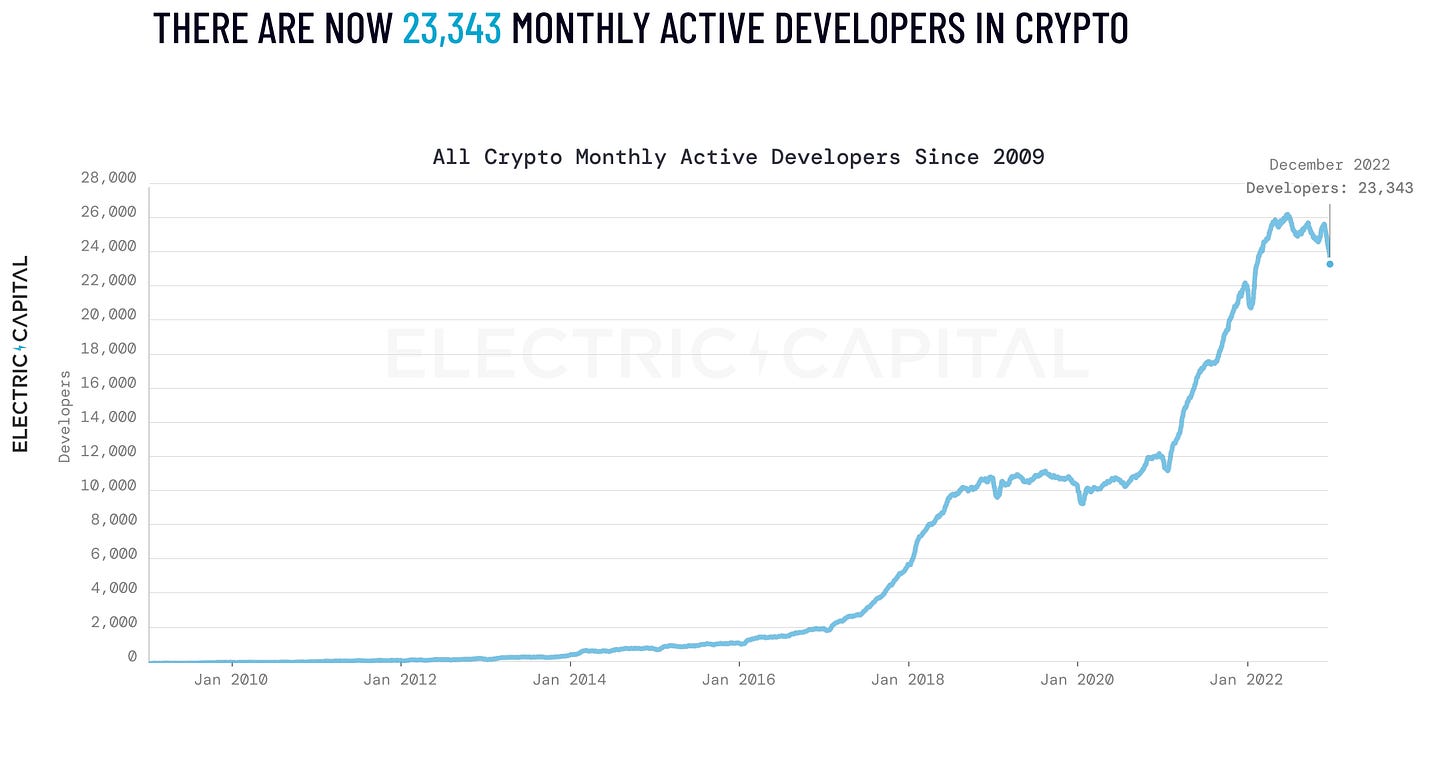Most Crypto Developers Aren't Working on Bitcoin or Ethereum
The results are in
Full-time crypto developers make up 76% of 2022 commits
Bitcoin and Ethereum lead way, but only 28% of all commits
Developers have choice of chains, good for decentralization
Software developers will likely decide which blockchains win
Bitcoin was the original open source cryptocurrency project. It inspired the founders of Ethereum to create a more advanced programmable money network - leading to the proliferation of DeFi, NFTs - and yes - web3.
Many other blockchains are now also wearing that open source hat originally worn by Bitcoin and Ethereum. Today, hundreds of thousands of open source commits are made to crypto software every month.

An ecosystem is emerging. And it’s not just Bitcoin and Ethereum anymore.
The investment firm Electric Capital puts out a yearly developer report on open source crypto. I analyzed it to take a look at what’s going on with developers and open source cryptocurrencies.
Please subscribe and pledge your support to the newsletter if you like this crypto content, I publish every week.
Over 20,000 Monthly Active Developers

Zero into Hero: From 2009 to 2022 the number of monthly active crypto developers grew to well over 20,000 souls. As of December 2022, there were 23,343 actively monthly developers.
While this is nowhere close to the Linux or Java communities, which have millions of monthly active developers, it’s a great start.

In fact, despite crypto prices trending down in 2022, there was 8% year-over-year growth in full-time crypto developers from 2021. Full-time developers contribute 76% of code commits, so they are by far the most important in crypto.
Bitcoin and Ethereum are Just Part of Crypto
The growth in blockchain networks has given developers a lot of choice in terms of what to work on. By the end of 2022, Bitcoin and Ethereum developers constituted just 28% of Electric Capital’s open source crypto activity analysis.

This activity was judged based on the analysis of 250 million open source code commits. Data from CoinGecko, CoinMarketCap, DappRadar, DefiLlama, Github, Gitlab and others were used to total this.
Top 200 Are Decentralizing Blockchains
The growth of smart contract or EVM networks outside of Ethereum gives the crypto world better optics. Especially when viewed through a decentralization lense. More blockchains diversify and better distribute the entire crypto industry.

Solana, NEAR, and Polygon grew 40% from 2021-2022 and have over 500 total monthly active developers. Sui, Aptos, Starknet, Mina, Osmosis, Hedera, Optimism and Arbitrum grew over 50% 2021-2022 and have 100 total monthly active developers.

Theses top 200 open source crypto ecosystems by net value outside of Bitcoin and Ethereum grew 12% year-over-year. This after a 2020 that saw incredible interest in the top 200, likely due to COVID restrictions that year - giving devs free time to find new tools to play with.
What’s Next For Bitcoin?
The two original gansters, Bitcoin and Ethereum, aren’t going anywhere. There’s just a further expansion in the ecosystem going on. Macroeconomic events since 2020 have accelerated this in ways many of us in crypto couldn’t have predicted.

Bitcoin, for example, has seen growth in developers since 2018. But major upgrades happen slowly with bitcoin. SegWit arrived back in 2017, and Taproot was implemented in late 2022.
It’s hard to compare Bitcoin with other, faster moving blockchains in terms of upgrades. And that’s okay - Bitcoin is still moving along and is providing a use case. The Taproot upgrade, in paricular, has led to Ordinals and Bitcoin NFTs.
What’s Next For Ethereum?
As for Ethereum, it still seems to be the entry point for developers getting interested in crypto. The growth of top 200 blockchain developers is clear. In addition, the number of new developers who come into crypto playing with Ethereum is also growing. They make up 16% of new entrants - the largest share for one blockchain.

There’s a likely a couple of reasons for this. The tooling for Ethereum has been around for a while, and it’s continually getting better. The Ethereum network’s been live since 2015, so there’s already lof of good hackers out there pushing smart contract code.
Next week, I’ll take a look at how developers will ultimately decide the future of these blockchain networks. Please subscribe! Thanks for reading.
To take a look at the 185-page 2022 Electric Capital Developers Report, check out the firm’s Github repository.





